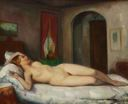Abraham Leon Kroll
American
(New York, New York, 1884 - 1974, New York, New York)
Leon Kroll was a prominent painter in the early twentieth-century New York art scene. Academicians and vanguard artists alike embraced this talented draftsman and technician as one of their own. Furthermore, Kroll’s outgoing and gregarious personality led him to befriend not only artists of varied philosophies, but also art patrons who were members of the social and political elite. Born in New York, Kroll began studying art as a seventeen-year-old at the Art Students League with the American Impressionist painter John Henry Twachtman; he later attended the National Academy of Design. Thereafter, Kroll supported his continued study with a series of prizes and scholarships, including an award that sent him to the Académie Julian in Paris in 1908. His skill in cultivating a professional support system, as well as his ability to capture coveted prizes, ensured a successful career. Although he was a product of the "establishment," around 1911 Leon Kroll befriended the artists associated with the McDowell Studio Club. This loosely knit exhibition society rejected the methods and philosophies of the New York art academies. In many respects, the McDowell Studio Club was a successor to The Eight, even including some artists associated with that earlier group, such as Robert Henri, John Sloan, William Glackens, George Luks, and Ernest Lawson, as well as their artistic heirs and students, George Bellows, Randall Davey, Edward Hopper, and Eugene Speicher. Invited to join these progressive painters, Kroll thus enjoyed recognition across stylistic barriers. Through the McDowell group, Kroll formed a close alliance with Bellows, who became an enthusiastic supporter of Kroll’s work. The success of Kroll’s Terminal Yards (1913, Flint Institute of Arts, Michigan) at the Armory Show established his reputation as an urban landscape painter. His works in this particular genre show a close affinity to similar subjects painted by Bellows, capturing the vitality of the city primarily through the built environment. Kroll continued to paint urban scenes, as well as pastoral landscapes, until about 1918, when he became more interested in the Post-Impressionists, particularly Paul Cézanne (1839–1906) and Vincent van Gogh (1853–1890). He began to move away from urban subjects to take a greater interest in depicting figures and, later, figures in landscape. The influence of Post-Impressionism, layered over the foundation of his academic training, is apparent in works from the later 1910s and 1920s, when Kroll turned to the nude as a primary subject. See: Leon Kroll: A Spoken Memoir. Ed. Nancy Hale and Fredson Bowers. Charlottesville: The University of Virginia Press for the University of Virginia Museum of Art, 1983. American Paintings from the Montgomery Museum of Fine Arts, 2006, cat. nos. 67 and 68, pp. 166-169.
American
(New York, New York, 1884 - 1974, New York, New York)
Leon Kroll was a prominent painter in the early twentieth-century New York art scene. Academicians and vanguard artists alike embraced this talented draftsman and technician as one of their own. Furthermore, Kroll’s outgoing and gregarious personality led him to befriend not only artists of varied philosophies, but also art patrons who were members of the social and political elite. Born in New York, Kroll began studying art as a seventeen-year-old at the Art Students League with the American Impressionist painter John Henry Twachtman; he later attended the National Academy of Design. Thereafter, Kroll supported his continued study with a series of prizes and scholarships, including an award that sent him to the Académie Julian in Paris in 1908. His skill in cultivating a professional support system, as well as his ability to capture coveted prizes, ensured a successful career. Although he was a product of the "establishment," around 1911 Leon Kroll befriended the artists associated with the McDowell Studio Club. This loosely knit exhibition society rejected the methods and philosophies of the New York art academies. In many respects, the McDowell Studio Club was a successor to The Eight, even including some artists associated with that earlier group, such as Robert Henri, John Sloan, William Glackens, George Luks, and Ernest Lawson, as well as their artistic heirs and students, George Bellows, Randall Davey, Edward Hopper, and Eugene Speicher. Invited to join these progressive painters, Kroll thus enjoyed recognition across stylistic barriers. Through the McDowell group, Kroll formed a close alliance with Bellows, who became an enthusiastic supporter of Kroll’s work. The success of Kroll’s Terminal Yards (1913, Flint Institute of Arts, Michigan) at the Armory Show established his reputation as an urban landscape painter. His works in this particular genre show a close affinity to similar subjects painted by Bellows, capturing the vitality of the city primarily through the built environment. Kroll continued to paint urban scenes, as well as pastoral landscapes, until about 1918, when he became more interested in the Post-Impressionists, particularly Paul Cézanne (1839–1906) and Vincent van Gogh (1853–1890). He began to move away from urban subjects to take a greater interest in depicting figures and, later, figures in landscape. The influence of Post-Impressionism, layered over the foundation of his academic training, is apparent in works from the later 1910s and 1920s, when Kroll turned to the nude as a primary subject. See: Leon Kroll: A Spoken Memoir. Ed. Nancy Hale and Fredson Bowers. Charlottesville: The University of Virginia Press for the University of Virginia Museum of Art, 1983. American Paintings from the Montgomery Museum of Fine Arts, 2006, cat. nos. 67 and 68, pp. 166-169.

